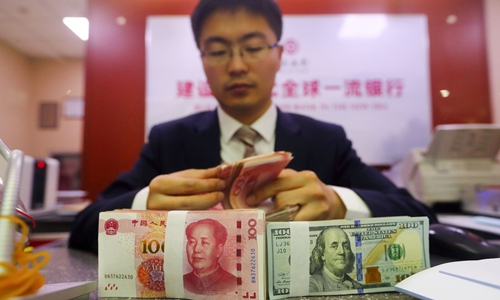HOME >> SOURCE
China cuts RRR to support economic revival
By Song Lin Source:Global Times Published: 2020/1/1 19:53:40
Move will ease peak liquidity demand before Lunar New Year holidays

A bank employee counts banknotes Photo: cnsphoto
In order to support the development of China's economic expansion and reduce the cost of corporate financing, the People's Bank of China (PBC), the country's central bank, decided on Wednesday to cut the required reserve ratio (RRR) for banks by 0.5 percentage points, which will take effect on Monday.
This RRR cut is across-the-board and reflects counter-cyclical adjustment, an official from the PBC said in a statement. The move came after Premier Li Keqiang said days ago that multiple measures will be considered to ease financing pressure on small businesses, such as RRR cuts, relending and rediscount.
As a means to directly support the real economy, the RRR reduction will release over 800 billion yuan ($114.9 billion) of long-term funds. This could effectively increase the supply of funds for financial institutions to support China's economy which was impacted by the trade war.
The RRR cut will maintain liquidity at a reasonably adequate level, and is conducive to preserving the supply of liquidity, as well as the expansion of the social financing scale in accordance with economic growth. It will give greater play to the decisive role of the market in allocating resources, and will support the development of the real economy, the statement said.
Meanwhile, the RRR reduction is also in line with China's existing prudent and flexible monetary policy, and came in a moderate and proper level in light of a possible liquidity shortage in the beginning of the year, Ming Ming, chief macro and fix income analyst with Citic Securities, told the Global Times.
The liquidity shortage in January may reach 2.8 trillion yuan, said media reports.
Ahead of the imminent Chinese Lunar New Year, the central bank's liquidity raising move could ease the escalating capital demand of all aspects during the new year peak season, Ming noted, as well as to supply liquidity for the issuance of special bonds and other debt issues at the beginning of 2020.
Rather than a move to flood the economy with a surplus supply of money, it shows the monetary policy's character of flexibility, Ming noted.
Against the backdrop of the mounting downward pressure on both the domestic and global economy, China's monetary policy would be more geared to serving the real economy, Zhou Yu, director of the Research Center of International Finance at the Shanghai Academy of Social Sciences, told the Global Times.
"Small and medium-sized enterprises, which are mostly private firms, have been major forces to boost employment and innovation in China," Zhou said.
Easing financing crunch of private firms is in line with China's annual Central Economic Working Conference, which was held in December. The conference clarified that the country will adopt a prudent monetary policy to stabilize economic growth, experts said.
According to the PBC statement, both big and small banks need to actively utilize the RRR cut to increase support for China's massive small and micro-sized enterprises, as well as private firms.
The cut does not extend to financial companies, financial-leasing companies or automobile finance companies, according to another statement from the PBC on Wednesday.
Posted in: MARKETS